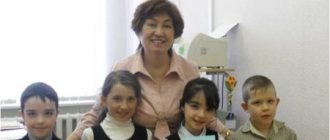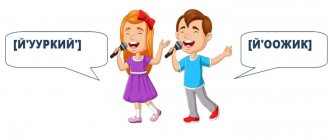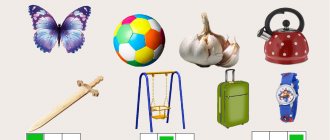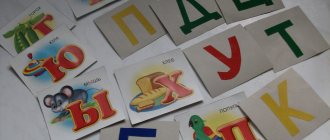Lesson notes - Differentiation of vowels of the first and second row
Summary of frontal speech therapy classes for first grade students
annotation
This development of a speech therapy lesson on the topic “Differentiation of vowels of the first and second row” is designed for first-grade students (IV quarter) in order to prevent errors associated with writing vowels, and can also be used in second grades for the purpose of correcting dysgraphic errors . This topic is studied after working on the following topics: “Vowels of the first row”, “Vowels of the second row”, “Hard and soft consonants”.
The development of the lesson is aimed at creating conditions for the full assimilation of the topic “Differentiation of vowels of the 1st and 2nd series.” Namely: to create a favorable emotional background through the use of gaming techniques; to include intact and activated mental functions into work; on the impact during the learning process on various analyzers: visual, auditory, motor; on the development of inter-analyzer connections: visual, tactile, auditory perception, visual mnesis, on the formation of stable letter gnosis.
The notes contain a detailed description of the progress of the speech therapy session. It reflects correctional tasks in accordance with the topic. The lesson contains stages of work that are interconnected.
The summary is addressed to speech therapists and primary school teachers.
Lesson notes
Lesson topic: “Differentiation of vowels of the first and second row in syllables, words, sentences.”
Lesson type: Combined
Lesson type: Mixed
Purpose of education: To learn to differentiate in written speech the vowels of the 1st and 2nd rows in syllables, words, sentences.
Objectives: Educational: To strengthen students’ ability to differentiate consonant sounds by hardness and softness, to teach them to use these skills when writing vowels in syllables, words, and sentences.
Correctional and developmental: Develop skills in sound-letter analysis and synthesis, phonemic perception, attention, fine motor skills and tactile sensations.
Educational: Develop the ability to listen to the instructions of the speech therapist and act in accordance with it; To foster a sense of mutual assistance and friendly attitude among students towards each other and others.
Materials and technical support of the lesson: Pictures depicting 2 clowns: a big one and a small one, object pictures, a “glove” manual, a bag, a box of letters, colored pencils of red, green and blue, pens, notebooks, a two-color cube of blue and green, chips blue, green and red, individual cards with tasks, pictures with the image of a sad and cheerful clown according to the number of students, individual mirrors.
During the classes:
1 Organizational moment.
Object pictures are placed on the board in the following sequence: CAT, BOW, WASPS, EAR, NOSE. - The one who names the first sound of the object shown in the picture will sit down. The speech therapist points to the picture in any order, the child selects the first sound and sits down in his place. Today we have a guest coming to our class. To find out who it is, name the first sounds of the objects shown in the pictures in order. Do you know who will come to us? (Clown)
2 Updating knowledge
There are 2 pictures on the board depicting a large and a small clown. — The clown came not alone, but with his friend. Let's get to know them. The speech therapist points to a large clown and introduces him to the children. - This is Bom the clown. Then he points to the little clown.
- And this is Bim the clown. The speech therapist places 2 pictures on the board with images of blue and green balloons.
— The clowns just can’t divide the balloons among themselves, each of them wants to take the green balloon and doesn’t want to give up. Do you ever have a situation where both you and your friend want to take the same toy or some other item? What do you do in such a situation? What is the right thing to do in such a situation? What should our guests, the clowns, do? Let us help them.
The speech therapist distributes individual mirrors to students. What is the first sound in the name Bom? ([b])
What sound is this, hard or soft? (Solid). Say the sound [b], look in the mirrors, how are your lips and tongue positioned when we pronounce this sound? What is the first sound in the name Bim ([b'])
What sound is it, hard or soft? (Soft) Pronounce the sound, consider the position of the lips and tongue when pronouncing the soft sound.
The speech therapist once again asks to pronounce sounds in pairs: [b] - [b'], to note the differences in the articulation of hard and soft sounds.
What color do we use to indicate hard sounds? (Blue) Soft sounds? (Green)
- Since the first sound in the name “Bom” is hard, we’ll give him a blue ball, and in the name “Bim” the first sound is soft, we’ll give him a green ball. So they helped the clowns divide the balls. In any situation you need to look for a compromise. Did you enjoy helping? The clowns are very happy that you helped them, and now they will not quarrel over the balls.
3. Introduction to the topic
Bim and Bom have prepared tricks and games for you. Let's play the game "Wonderful Bag". The speech therapist takes a bag containing letters and approaches each student. The guys feel for the letter, name it, then take it out of the bag. The rest of the guys and the speech therapist check whether he guessed the letter correctly. - You have letters in your hands. What letters are these? (Vowels) - How many vowels are there in the alphabet? Count how many letters you all took out of the wonderful bag. (10 letters) - There are 10 vowel letters in the Russian alphabet. - What two groups can we divide all vowels into? (For vowels of the first and second row). If the children do not name which 2 groups the vowels are divided into, the speech therapist himself reminds the students that all vowel letters are divided into vowels of the first and second row and asks the children to think about what the topic of the lesson will be.
4. Reporting the topic of the lesson
— Clowns, they want to see how you can distinguish between the vowels of the first and second rows in written speech. And today in class, together with them, we will distinguish these vowel letters in syllables and words. Open your notebooks and write down the number.
5. Work on the topic of the lesson
5.1 Differentiation of vowels of 1st and 2nd rows
“You helped the clowns today, and now they will help you.” So that you can quickly remember which vowel letters belong to the first row and which to the second, the clowns brought you magic gloves.
On the board, the speech therapist places red gloves made of cardboard. — Clown Bom brought his right glove and asked him to decorate it with vowels of the 1st row. Guess these vowels based on the articulation of the sounds.
The speech therapist silently pronounces the vowel sounds [A, [O], [U], [Y], [E], students name the vowel sound, the one who has such a letter on their desk goes to the board and, with the help of the speech therapist, places it on the fingers of the right glove as follows: on the thumb the letter A, on the index finger - O, on the middle finger - U, on the ring finger - Y, on the little finger - E. Next, the speech therapist once again focuses the students’ attention on the fact that we have placed the vowels of the first row on the right glove.
— Clown Bim brought the left glove, let’s decorate it with the letters remaining on your desks.
Students, together with the speech therapist, place the remaining vowels on the fingers of the left glove (thumb - I, index - E, middle - Y, ring finger - I, little finger - E), and the speech therapist draws the students’ attention to the fact that we have placed vowels on the left glove letters of the second row.
— So we decorated the clowns’ gloves. Name the vowels of the first row, and then the vowels of the second row. Now close your eyes, imagine gloves in front of you, with vowel letters placed on them, and once again name the vowels of the first and second row.
5.2 Differentiation of vowels of 1st and 2nd rows in syllables
The speech therapist places black and white pictures on the board with images of balloons in which the syllables are written: LA, LA, LO, LE, LU, LYU, LY, LI, LE, LE.
— Determine whose balls are the clown Bim or the clown Bom? Read the syllables on the balls. Highlight the first sound in the word. Determine whether it is hard or soft. The clowns have a hint for you, look at the balls that we gave them at the beginning of the lesson, if you hear a hard sound in a syllable, then this is a clown ball...., if you hear a soft consonant sound, then this is a clown ball....
Along the chain, students read the syllables, identify and identify the sound, and say whose ball it is. The speech therapist “distributes” the balls to the clowns and places them near the gloves of each clown.
5.2.1 Reading syllables
- Read the syllables on each clown’s balloons. Pay attention to the vowel letters in the syllables and the letters placed on the gloves. What conclusion can be drawn? (The vowel letters in the syllables coincide with the vowel letters placed on the gloves.) If the consonant sound in a syllable is hard, then what letter do we write after the consonant letter? If the consonant sound in a syllable is soft, then what letter do we write after the consonant letter?
Students once again read the syllables written on the balloons, first Bom the clown, then Bim the clown. They conclude that if the consonant sounds are hard, then after the consonant letter we write the vowels of the 1st row, placed on the right glove; if the consonant sound is soft, then after the consonant letter we write the vowels of the 2nd row, placed on the left glove.
Next, the syllables are read in pairs, starting with the thumbs of the right and left hands, then with the index fingers, etc. (A-Z, O-Y, U-Y, Y-I, E-E)
5.2.2 Working with a cash register of letters and blue, green, red chips.
The speech therapist removes the pictures of clowns, leaving on the board gloves with colored balls embedded in them (blue in the right glove, green in the left glove), and distributes chips.
— The clowns have prepared songs for you. Guess who is singing, Bim the clown or Bom the clown. How will we determine who sings? What should you pay attention to when determining? (We will determine the hardness and softness of consonant sounds). If the syllable has hard consonant sounds, then Bom sings, if there are soft consonants, then Bim sings.
— The clowns brought with them blue, green and red balls (chips). Now you will juggle these balls. The clowns will sing their songs again, and if you hear a hard consonant sound and a vowel sound, take ... and ... a ball, if a soft consonant sound and a vowel sound, then ... and ... a ball.
Use the box of letters to form what the clown sang. If the first sound is soft, then what vowels should we put after the consonant? And if the consonant sound is hard, then what vowel letters should we put after the consonant letter?
The speech therapist reads out the syllables: RA, NE, NA, NU, LYU, LA, KO, VE, MYA, GA, TU, etc. (Most often, students do not know how to differentiate A-Z, O-Y, U-Y , therefore, these vowel letters are included in the exercises, and we do not focus on the remaining pairs. If students find it difficult to differentiate the remaining pairs of vowel letters, then we include them in the exercises.)
Students determine who is singing, choose chips of the color corresponding to the sounds (blue and red or green and red), looking at the gloves, and blue and green balls make up syllables from the bank of letters.
Phys. just a minute
Clown Bim and Clown Bom Tell you all to “Rise!” They stood straight at their desks. The clowns tell us. Clown Bim suddenly leaned over, and then Bom sat down. Bim jumped and turned around, Bom just looked at him. And then Bom stretched, straightened up, walked, Bim - frowned, straightened up, picked up the balls from the ground. We had time to relax with you and sat down quietly at our desks!
5.2.3 Game "Cube"
— The clowns brought a cube. Let's play a game. The speech therapist takes out a two-color cube: blue and green and hands it to the student. -Roll the dice. If the cube falls on the blue side, make a syllable with a hard consonant; if with the green side, then with a soft consonant. Write down the resulting syllable in your notebook, explaining the choice of vowel letter. Check the spelling of the vowel letter: indicate the sounds in the written syllables with the corresponding colors.
Students take turns rolling the dice and naming the syllable according to the color of the side of the dice that appears. Then write down the syllable in a notebook, commenting on the choice of vowel letter. Under the letters, circles are drawn that correspond to the sound of the color.
5.3 Differentiation of vowels of rows 1 and 2 in words
5.3.1 Working with word diagrams and subject pictures
— The clowns wanted words to appear under the pictures, but the trick didn’t work, only diagrams of words appeared and they couldn’t figure out which picture they matched. Help the clowns. Match each picture with the corresponding word pattern. Write these words down. For the remaining pictures, make your own diagrams and write down the words.
The speech therapist places on the board diagrams of words like: and I (bathhouse) and subject pictures: BATH, EYE, HAT, CAMEL, MOON, NOSE, CHERRY, BIRCH, MAPLE, ROSE, HOUSE. Students select diagrams, looking at the “Gloves” manual, write down the words.
5.3.2 Working with individual cards.
— The clowns want to check how you have learned to distinguish between the vowels of the first and second rows in words and have prepared a task for you. The speech therapist distributes individual cards.
- Write down the words. Leave in the word only those vowel letters that fit. Students complete the task independently, then read the words in a chain and name the inserted letters, explaining.
B(o,yo)rya, L(u,yu)ba, Tan(a,ya), L(u,yu)da, Ol(a,ya), Vas(a,ya), Kol(a,ya) ), Irin(a,ya); T(a,i)nut, Gl(a,i)de, n(u,yu)hat, cleanse(a,i)t, carry(o,e)m, priv(o,e)z.
5.4 Differentiation of vowels of the first and second row in sentences
5.4.1 Working with deformed sentences
- Bim and Bom have prepared wishes for you. Unscramble them and insert the missing letters.
| 3 | 2 | 1 | 4 |
| V | get to know | other sons | trouble |
| 1 | 3 | 2 | 4 | 5 |
| l.day | By | remember t | their | del.m |
| 3 | 4 | 1 | 5 | 2 |
| knot | Not | one | chewing | r.koy |
The speech therapist divides the children into groups of 2 and distributes to each group tables with words and a number row corresponding to the order of words in a sentence. Students compose, write down, and then read out the resulting wishes. Each group must explain the understanding of the proverb. The speech therapist listens to explanations in case of difficulty or incorrect explanation; the speech therapist explains the meaning of the proverbs and asks everyone to take home a proverb with the same meaning.
5.4.2 Self-test
After the students complete the task, the speech therapist opens a part of the board on which the data was pre-written in sentence tables with the vowels inserted correctly. Students check their spelling.
6 Summary.
-So, our lesson has come to an end. Let's repeat what we talked about in class today? How many vowels are there in the alphabet? Name the vowels of the first row, name the vowels of the second row. What do we pay attention to in order to write a vowel letter correctly? If the consonant sound is hard, then after the consonant letter we write vowels…., If the consonant sound is hard, then after the consonant letter we write vowels….
7. Reflection
The speech therapist gives each student 2 pictures depicting a sad and cheerful clown. - Evaluate your work in class. If it was easy for you to complete the tasks, bring up a picture with the image of a cheerful clown, but for those who found it difficult to complete the tasks, or some of you did not understand when we write vowels of the first row in syllables, words, and when we write the second, raise a picture with the image of a sad clown. It's time for the clowns to say goodbye to us. They say thank you for your help.
Bibliography
- Efimenkova, L.N. Correction of oral and written speech for primary school students [Text]: A manual for speech therapist. /L. N. Efimenkova / – M.: Humanit. ed. VLADOS center, 2003. – 232 p.
- Speech therapy: Textbook for students of defectology. fak. ped. universities [Text]/ Ed. L.S. Volkova, S.N. Shakhovskaya. — M.: Humanite. ed. VLADOS center, 1998. - 680 p.
- Mazanova E.V. Correction of acoustic dysgraphia. Lesson notes for speech therapists/E.V. Mazanova. – 2nd ed., rev. – M.: Publishing house GNOM and D, 2010. – 184 p.
- Sadovnikova, I.N. Impaired written speech in primary schoolchildren. [Text]/ I.N. Sadovnikova / – M., 2003. – 296 p.
The author of the material is a teacher - speech therapist, Municipal budgetary educational institution "Secondary school No. 6" Salekhard, Yamalo-Nenets Autonomous Okrug: Elena Alekseevna Gondar
Also on topic:
Differentiation of vowels of the first and second series U-Yu
Stressed and unstressed vowel sounds
Vowel sounds are:
- percussive: juice [o] - ice ['o], forest ['e] - mayor [e], drill [u] - hatch ['u],
- unstressed: vo da [a], su dak [u], le sok [i].
Note. It is correct to say “stressed syllable” and “unstressed syllable”. Instead of “the stress falls on the vowel,” say “the stress falls on the syllable with the vowel.” However, in the literature there are formulations “stressed vowel” and “unstressed vowel”.
Stressed vowels are in a strong position and are pronounced with greater force and intonation. Unstressed vowels are in a weak position, they are pronounced with less force and can be subject to change.
Note. The designation of the letter e in weak position differs in different school programs. Above we showed the sound [and], in other school programs the designation [e] is found, in the institute program - [e and ] (e with the overtone and).
Scheme 2. Division of vowels into stressed and unstressed.
In the Russian language there are compound words with primary and secondary stress. In them, we highlight the main stress with strong intonation, and the secondary stress with weak intonation. For example, in the word foam blocks, the main stress falls on the syllable with the letter o, the secondary stress on the syllable with the letter e. In phonetic analysis, the vowel with the main stress is stressed, the vowel with the secondary stress is unstressed. For example: tricuspid, three-year-old.
IV. Differentiation s - and in syllables.
1. Listen to the syllables. Say what vowel you hear.
A
) Py. you, we, sy, ry, dy, would, ky;
b) pi, ti, mi, si. ri.di. bi, ki
“How are the consonants you heard first and then pronounced? (Hard, soft)
What sound here indicates the softness of the consonants? - asks the speech therapist.
2. Repeat the syllables after the speech therapist.
Py - pi - pi, ti - you - ti sy - sy - si ri - ry - ry dy - di - dy.
3. Write the syllables in two lines: s ы on the first line, s i on the second.
We, si, sy, mi, ry, ri, ti, you, ky, ki, li, pi, py, ly.
Task 4. Complete the words by inserting the syllables given in brackets.
Gri...(would), li...(py), le...(pi), bo...(would), ru...(ki),
ry...(would), la...(py), but...(gi), books...(gi), so...(you),
ke...(dy), be...(gi), ke
d...(ry),
ko ...(you), ka...(ti).
V. Summary of the lesson.
Yotated vowel sounds
The letters i, yu, e, e are called iotized and mean two sounds in the following positions of the word:
- at the beginning of the word: fir tree [y"olka], Yana [y"ana], raccoon [y"inot];
- after a vowel: hare [zai"its], bayan [bai"an];
- after ь or ъ: streams [ruch"i", rise [fall"om].
For ё and stressed vowels I, yu, e, a replacement is made: I → [y'a], yu → [y'u], e → [y'e], ё → [y'o]. For unstressed vowels, a replacement is used: i → [th"i], e → [th"i]. In some school programs, when compiling a transcription of a word and during phonetic analysis, the Latin j is written instead of th.
Goals:



